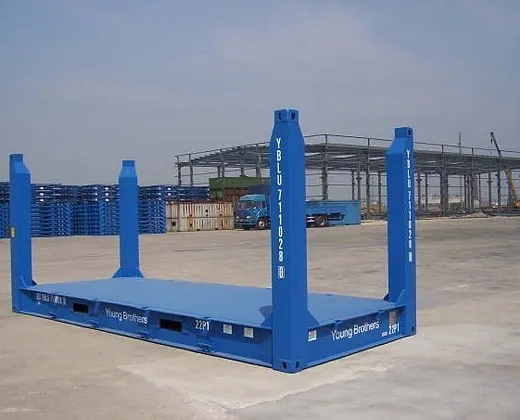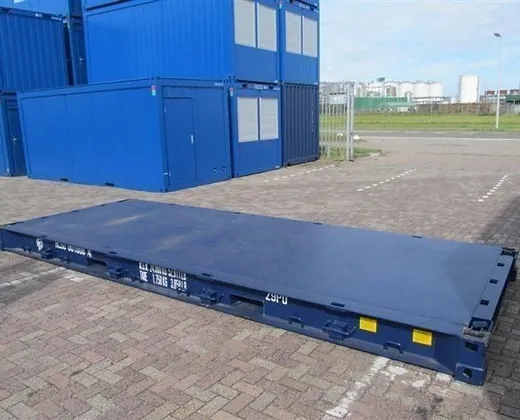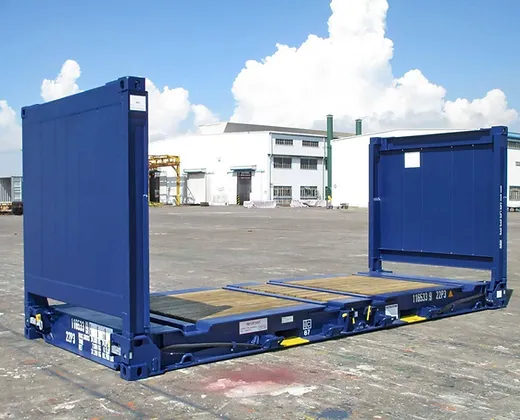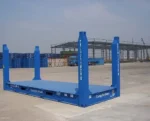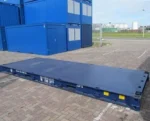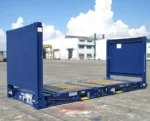Description
-
Caractéristiques techniques
Les Flat Rack sont utilisés pour le transport de charges lourdes et de cargaisons « oversize » hautes et larges tel que : bateau, pièces d’avion, engins agricoles, mobil-home, machinerie lourde, tuyauteries, grumes, matériaux de chantier.
Spécificités :
Livraison en Europe, livré et déchargé sur site
Imperméable / Étanche (intempéries, lumière)
Solution multimodale adaptée à l’import / export
Caractéristique Techniques :
Classique Flat Rack
Passage de fourches 2050mm
Adapté aux charges lourdes 50 tonnes
Argumentation CSC
(Convention internationale sur la Sécurité des Conteneurs). Flat Rack :
Adapté aux gros gabarits
Structure acier CORTEN
Plancher acier ou bois renforcé
Modèles :
Le conteneur 20 FLAT PLATFORM
Plateforme simple avec un passage de fourches pour manipuler le conteneur.
Le conteneur 20 pieds FLAT FIX HANDS Plateforme avec 4 poteaux ou deux parois fixes avec les coins ISO.
Le conteneur 20 pieds FLAT RACK COLLAPSIBLE Plateforme avec 2 parois amovibles et encastrables, solution idéale pour stocker un grand nombre de
conteneur FLAT sur un espace restreint , et solution économique pour leur transport
Informations complémentaires :
Poids à vide : 2300 Kg
Charge max : 26000 Kg
Poids max : 28300 Kg
Surface : 13,8m2.
Dimensions Intérieures :
Longueur : 5890 mm
Largeur : 2440 mm
Hauteur : 2590 mm
Dimensions Extérieure
Longueur : 6060 mm
Largeur : 2440 mm
Container flat rack Neuf 20 pieds
Disponibles en 3 modèles (PLATFORM, FIX HANDS et COLLAPSIBLE) et deux dimensions, 20 et 40 pieds et ont des dimensions standardisées, communes aux conteneurs 20 pieds et 40 pieds classiques. La charge utile statique d’un Flat Rack plat de 20 pieds est d’environ 25 tonnes.
1,560.00€ Le prix initial était : 1,560.00€.960.00€Le prix actuel est : 960.00€.
Référence : CM6328979
Commentaires des clients
Online Sports Nutrition and Natural Dietetics.
Chances are there wasn't collaboration, communication, and checkpoints, there wasn't a process agreed upon or specified with the granularity required. It's content strategy gone awry right from the start. Forswearing the use of Lorem Ipsum wouldn't have helped, won't help now. It's like saying you're a bad designer, use less bold text, don't use italics in every other paragraph. True enough, but that's not all that it takes to get things back on track.
The villagers are out there with a vengeance to get that Frankenstein
You made all the required mock ups for commissioned layout, got all the approvals, built a tested code base or had them built, you decided on a content management system, got a license for it or adapted:
- The toppings you may chose for that TV dinner pizza slice when you forgot to shop for foods, the paint you may slap on your face to impress the new boss is your business.
- But what about your daily bread? Design comps, layouts, wireframes—will your clients accept that you go about things the facile way?
- Authorities in our business will tell in no uncertain terms that Lorem Ipsum is that huge, huge no no to forswear forever.
- Not so fast, I'd say, there are some redeeming factors in favor of greeking text, as its use is merely the symptom of a worse problem to take into consideration.
- Websites in professional use templating systems.
- Commercial publishing platforms and content management systems ensure that you can show different text, different data using the same template.
- When it's about controlling hundreds of articles, product pages for web shops, or user profiles in social networks, all of them potentially with different sizes, formats, rules for differing elements things can break, designs agreed upon can have unintended consequences and look much different than expected.
This is quite a problem to solve, but just doing without greeking text won't fix it. Using test items of real content and data in designs will help, but there's no guarantee that every oddity will be found and corrected. Do you want to be sure? Then a prototype or beta site with real content published from the real CMS is needed—but you’re not going that far until you go through an initial design cycle.



